Do You Text? 4 Yoga Poses for Sore Shoulders

Article At A Glance
The more time you spend communicating through your devices, the more likely it is that you’ll experience neck and shoulder pain. This is because head-forward, bent-over posture makes your neck and shoulders have to work a lot harder. But yoga can help. Here are four poses that can help counteract the postural effects of using our devices.
I haven’t gotten fully into the texting habit. It’s not that I don’t appreciate the convenience. It’s that I don’t want to have yet another device I have to check many times a day. I also don’t want to get into unhealthy postural habits that often accompany texting. Continually bending forward over your device can result in sore shoulders and neck, as well as “text claw.” The good news is that there are lots of yoga poses for sore shoulders.
A while back, I wrote an article about “text neck,” a relatively new postural malady that affects texters from their teenage years onward. Here’s a quote from the article:
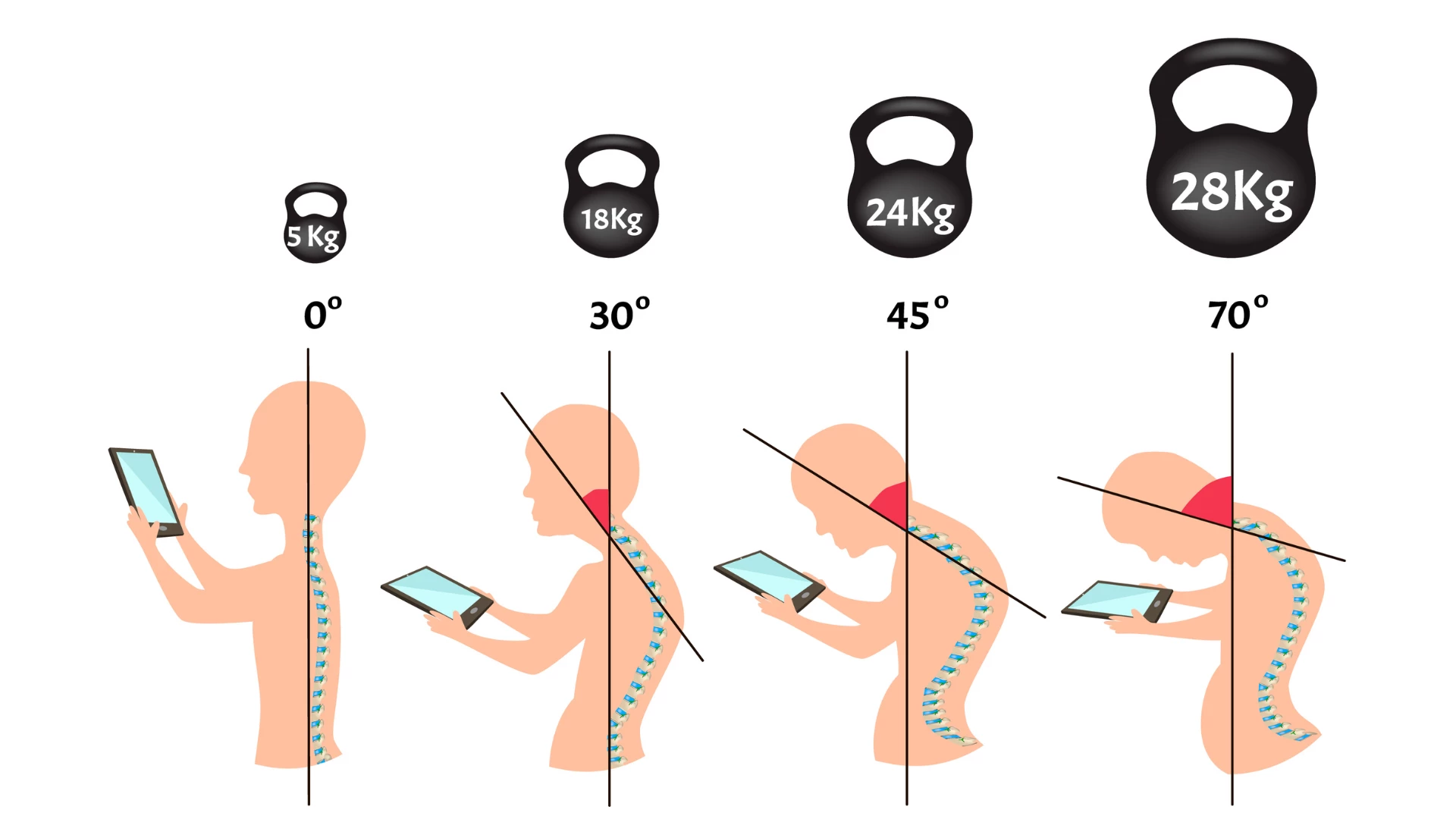
“When your spine is in a neutral position with your head resting atop your neck, your head weighs 10-12 pounds. Our spines are designed to bear this weight, no problem. For every 10 degrees, you flex your neck forward, your head exerts more weight on your neck. At a 60-degree angle, your head exerts 60 pounds of force on the cervical spine. The effect of the constant weight on the delicate cervical vertebrae can, over time, reverse the curve of your cervical spine, causing pain and disc dysfunction.”
Because the neck and shoulders are intimately connected, that 60 pounds of force on your neck affects your shoulders, too. Rounding your shoulders seems to go with the territory.
YOU CAN TEXT AND KEEP YOUR SHOULDERS HAPPY TOO
The good news is that with awareness, we can prevent some of the problems associated with the head-forward, shoulder-slumping positions. When I use my smartphone, I make a point to lift it high enough that I can look straight ahead. This may look a little dorky, but it gives my neck and shoulders more movement choices. Of course, it’s not sustainable in the long run because my arms get tired. But since I don’t text all that much, it works for me.
The other thing I do to avoid smartphone-related postural maladies is to do most of my texting on my computer. When I sit at my computer, there’s no need to slump forward or lower my head. Also, I type much faster on the computer than I do on my phone!

Most people text a whole lot more than I do. If you text a lot, holding your phone up while you text isn’t practical. But all is not lost. There’s always yoga! There are many yoga poses for sore shoulders and neck. The following list includes lateral extensions and twists because these are the ways the thoracic spine moves easily. (Starting with these poses can mobilize your spine for back bending as well.) Here are just a few yoga poses for sore shoulders.
4 YOGA POSES FOR SORE SHOULDERS
1. Palm Tree Pose (Talasana)
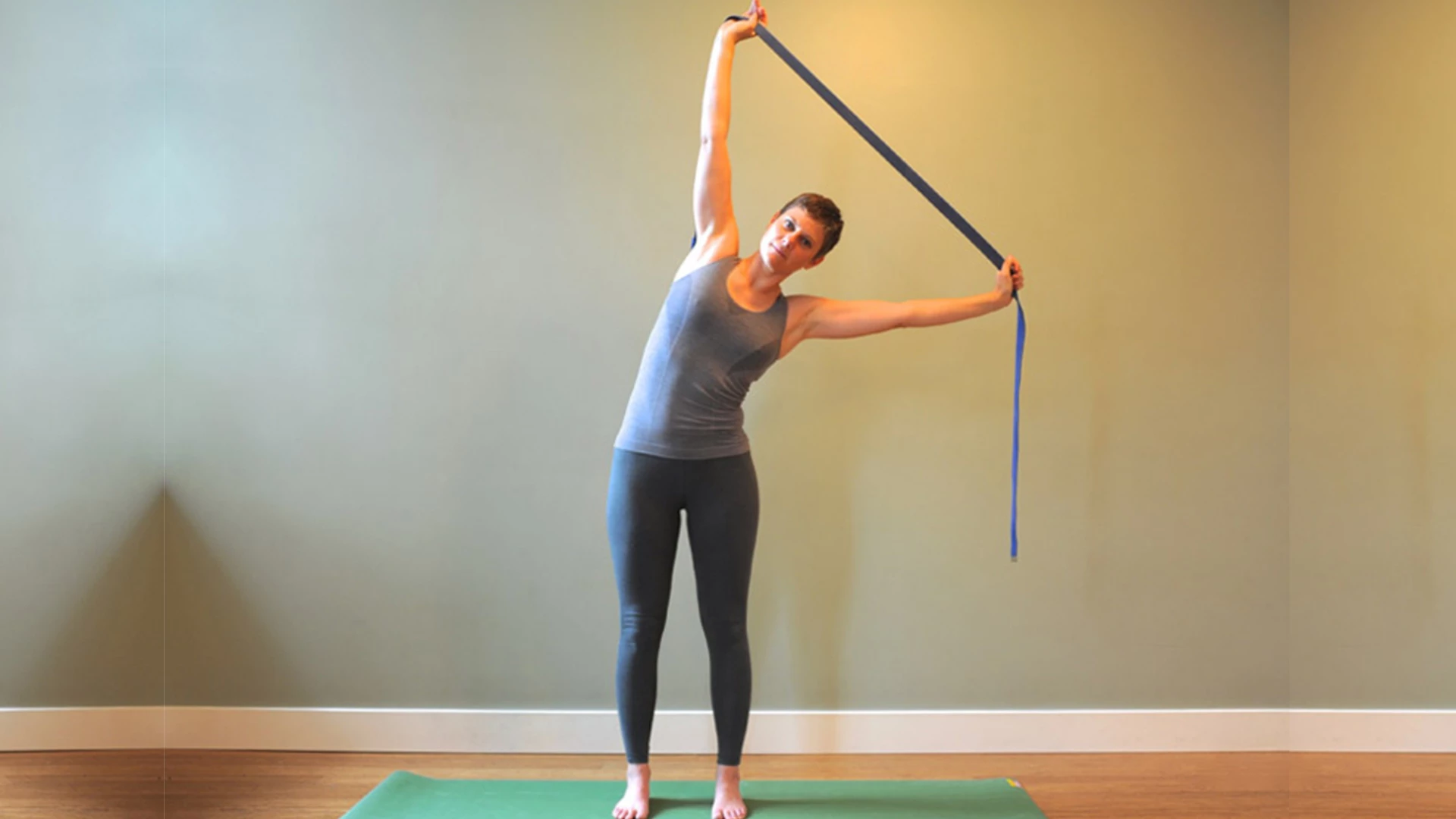
A standing lateral bend, Talasana is a great all-over stretch.
- Stand in Mountain Pose (Tadasana) with your feet hips-width apart.
- Raise your arms overhead. You can either clasp your left wrist with your right hand or use a yoga strap to connect your hands.
- Bend your torso laterally to the right. Start by stretching laterally, and then feel free to explore other spinal movements, such as twisting and backbending while your arms are overhead.
- Return to the center and release your arms. Take a few moments to feel the effects of the pose.
- Raise your arms overhead again, and repeat on the other side.
2. Eagle Pose Arms (Garudasana Arms)

Garudasana is traditionally practiced as a balance pose. But practicing the arm position on its own can help relieve stress between the shoulder blades. It may seem counterproductive to practice a pose that causes the shoulders to round. But a focused practice of Garudasana arms can help unwind the tension accumulated as the muscles around the shoulder blades work to keep your head stable while texting. Try practicing Garudasana arms while in Tadasana rather than in the balance pose, so that you can focus on the shoulders without worrying about losing balance.
- Stand in Mountain Pose with your feet hips-width apart.
- Cross your right upper arm over your left. Then, bend your elbows so that your forearms are vertical. Connect the fingers of the left hand with the palm of the right hand.
- If placing the fingers of your left hand into your right palm doesn’t work for you, use a yoga strap to connect your hands.
- With your arms in position, breathe deeply into the space between your shoulder blades. Also, try making big, slow circles with your arms to mobilize your shoulders. Circle your arms both clockwise and counterclockwise.
- Release your arms, allowing them to hang for a few breaths. Tune into what you feel in your shoulders.
- Cross your left arm over your right and practice your other side.
3. Revolved Lunge Pose (Parvrtta Anjaneyasana)
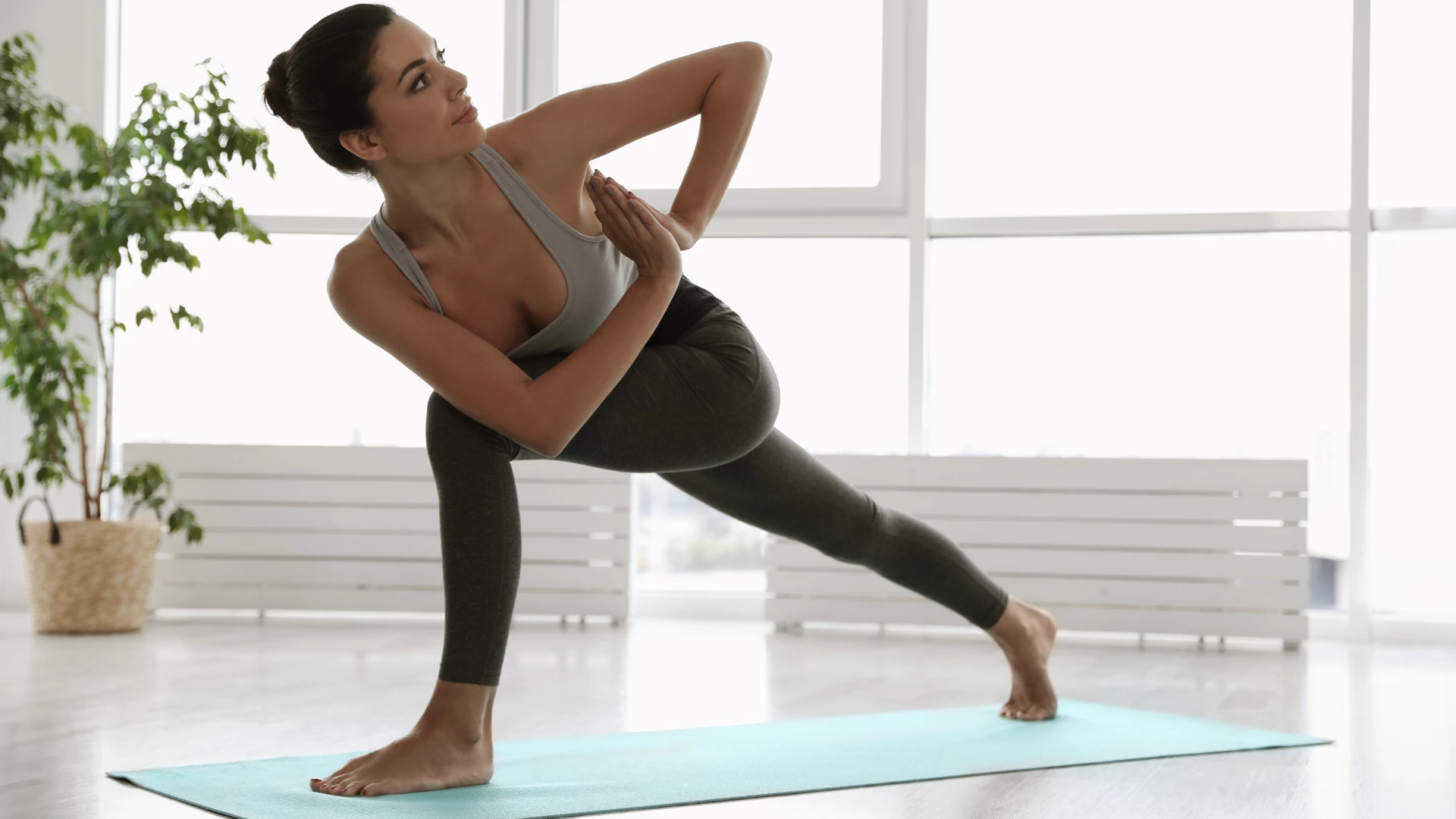
So far, I’ve recommended practicing yoga poses for sore shoulders from a standing position. This is because we generally work on our devices from a seated position. It doesn’t hurt to enliven the whole body while you focus in on your shoulders. I like this particular twist a lot because it offers lots of movement options.
- Begin in Mountain Pose with your feet hips-width apart.
- Fold forward from your hip joints into a Standing Forward Bend Pose (Uttanasana). Allow your knees to bend enough so that your pelvis is tipping forward. Take a few deep breaths here, allowing your body to relax.
- Bend your knees so that you can place your hands on the floor on either side of your feet.
- Step your left leg straight back. Your right knee should be in a 90-degree angle, and your knee should be directly over your ankle. Your hands should be on the floor on either side of your right foot.
- Stretch back through your left heel to activate the left leg.
- Take a few breaths in this position. Make sure to activate both legs so that you’re not collapsing into your hands.
- Now press your left hand into the floor and rotate your torso toward your right leg. You can either extend your right arm upward or place your right hand on your hip.
- Lengthen your spine, keeping your legs active so that you’re not collapsing into your left hand.
- Breathe into the twist.
- After 5 to 10 deep breaths, release your right hand back to the floor, coming back to a neutral lunge.
- Step your left leg forward, returning to Uttanasana.
- Bend your knees deeply and lift up part-way toward standing. Pause for a few breaths, resting your elbows on your thighs. Then, lift up to Tadasana. (Pausing halfway up can help prevent dizziness when you return to Tadasana from Uttanasana.)
- Take a few breaths in Tadasana to tune into the aftereffects of the pose.
- Repeat on the other side.
4. Supported Fish Pose (Salamba Matsyasana)
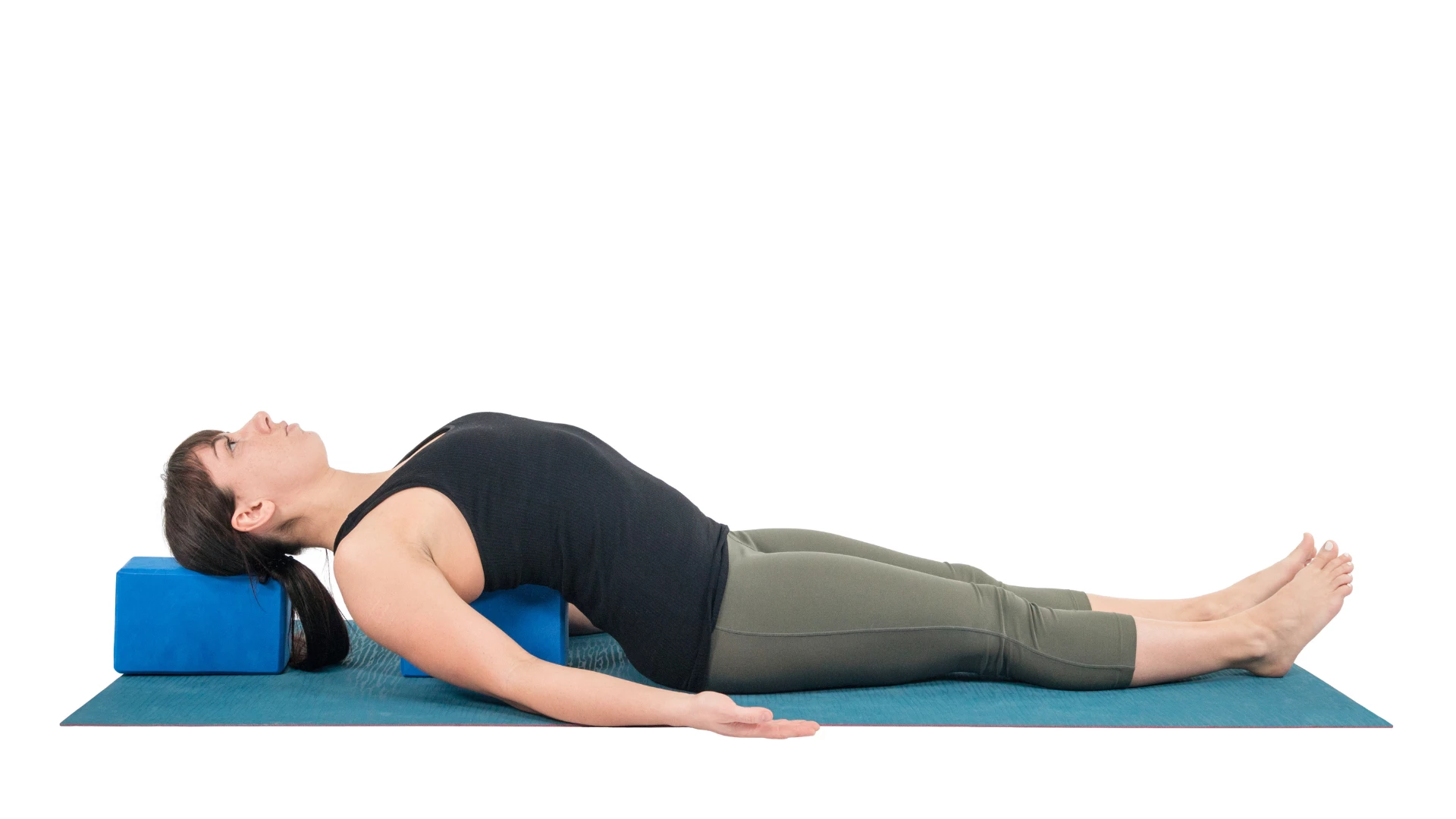
Supported Fish Pose is one of yoga’s most effective poses for expanding the chest. You can use two yoga blocks or a yoga bolster for support. Make sure you place enough support under your head so that it is not tilting back. If your head tilts back in this pose, it can be very uncomfortable and can actually create more neck and shoulder tension.
For this pose, you’ll need two yoga blocks or a bolster, as well as a firm yoga blanket or two.
- Lay two blocks end to end on your yoga mat, either at their lowest or medium height. Or place a bolster lengthwise on your mat.
- Place a folded blanket on top of the block closest to the head end of your mat or on the head end of your bolster.
- Sit in front of your blocks or bolster so that your glutes are a few inches from your props.
- Lie back onto your blocks or bolster and adjust the folded blanket to support your head and neck. If your head is tilting back, return to sitting and add another folded blanket.
- If you’re using blocks, sometimes the edge of the block that’s supporting your shoulders can feel uncomfortable. If so, you can place a blanket over the blocks to soften the edges.
- Once you’ve found a comfortable position, lie on your props, allowing your arms to rest at a 45- to 90-degree angle from your sides.
- Relax and breathe here for 5 to 10 minutes or more.
- To leave the pose, draw your arms in, close to your sides, and push yourself up to a seated position.
Finally, don’t forget to give yourself a long Relaxation Pose (Savasana). Try for 10 to 15 minutes.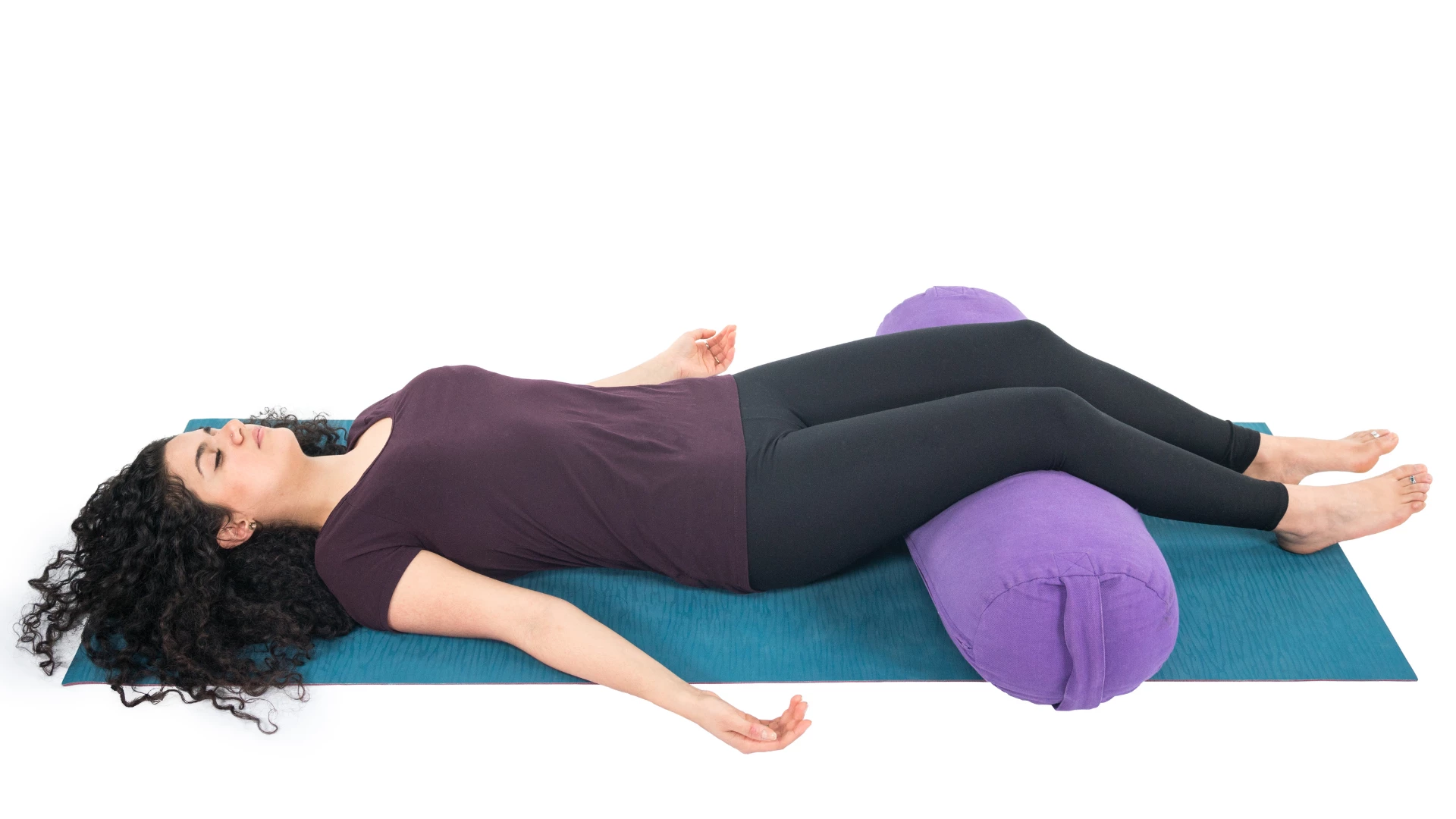
Also, read...
Free Yoga Video: 3 Somatic Yoga Practices to Help Enhance Postural Awareness
How Well Are You Aging? An Easy Test of Health and Longevity
6 Yoga Poses to Counteract the Effects of Sitting
Related courses
Breath as Medicine: Yogic Breathing for Vital Aging
Yoga and Myofascial Release: Releasing Chronic Tension with the Bodymind Ballwork Method

Charlotte Bell began practicing yoga in 1982 and began teaching in 1986. She was certified by B.K.S. Iyengar in 1989 following a trip to Pune. In 1986, she began practicing Insight Meditation with her mentors Pujari and Abhilasha Keays. Her asana classes blend mindfulness with physical movement. Charlotte writes a column for Catalyst Magazine and serves as editor for Yoga U Online. She is the author of two books: Mindful Yoga, Mindful Life, and Yoga for Meditators, both published by Rodmell Press. She also edits Hugger Mugger Yoga Products’ blog and is a founding board member for GreenTREE Yoga, a non-profit that brings yoga to underserved populations. A lifelong musician, she plays oboe and English horn in the Salt Lake Symphony and the folk sextet Red Rock Rondo whose 2010 PBS music special won two Emmys.



